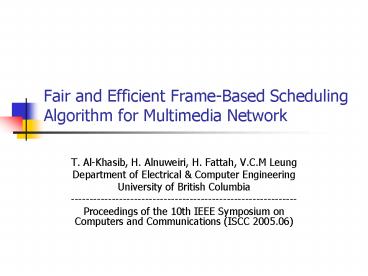Fair and Efficient FrameBased Scheduling Algorithm for Multimedia Network
1 / 24
Title:
Fair and Efficient FrameBased Scheduling Algorithm for Multimedia Network
Description:
... packets are given a time related stamp upon their arrival to the system. ... In RR, backlogged sessions are served in sequence, one packet at a time. ... –
Number of Views:69
Avg rating:3.0/5.0
Title: Fair and Efficient FrameBased Scheduling Algorithm for Multimedia Network
1
Fair and Efficient Frame-Based Scheduling
Algorithm for Multimedia Network
- T. Al-Khasib, H. Alnuweiri, H. Fattah, V.C.M
Leung - Department of Electrical Computer Engineering
- University of British Columbia
- --------------------------------------------------
----------- - Proceedings of the 10th IEEE Symposium on
Computers and Communications (ISCC 2005.06)
2
Outline
- Introduction
- Other scheduling algorithm
- Mini Round Robin (MRR)
- Analysis Simulation
3
GPS
- Modern packet scheduling theory is based on few,
but very powerful, concepts. One such concept is
Generalized Processor Sharing (GPS) - GPS can provide every flow with its guaranteed
bit rate, and at the same time, distribute excess
bandwidth fairly among all contending flows
according to their relative reserved rates. - GPS is based on a fluid model that is,
unfortunately, not implementable in packet data
networks
4
category
- Packet schedulers can generally be classified
into two main categories - 1 timestamp-based schedulers
- Weighted Fair Queuing (WFQ)
- Worst-case Fair Weighted Fair Queuing (WF2Q)
- Virtual Clock (VC)
- Self- Clocked Fair Queuing (SCFQ).
- 2frame-based schedulers.
- Weighted Round Robin (WRR)
- Deficit Round Robin (DRR)
- Elastic Round Robin (ERR)
5
timestamp-based schedulers
- In timestamp-based schedulers packets are given a
time related stamp upon their arrival to the
system. The time stamp is used by the scheduler
to determine the sequence in which packets depart
the system. - Timestamp-based schedulers can achieve a good
approximation of the GPS fluid model by providing
tight and low latency bounds, and providing good
fairness. A major drawback of these schedulers is
their unavoidable high work complexity.
6
frame-based schedulers
- Frame-based schedulers, on the other hand, serve
flows in rounds or frames. During each round a
flow receives at least one transmission
opportunity. - This type of schedulers is generally known for
its simplicity and low work complexity.
7
RR
- In RR, backlogged sessions are served in
sequence, one packet at a time. All flows are
treated similarly regardless of their reserved
rates. The RR algorithm is fair as long as the
same fixed packet size is used for all contending
flows, and all flows have the same reserved rate.
RR is simple because it is stateless and has an
O(1) per packet work complexity. - However, under more realistic assumptions, such
as variable packet sizes and session rates, RR
performs quite poorly both in terms of fairness
and delay.
8
WRR
- To support flows with different reserved rates,
Weighted Round Robin (WRR) was introduced . - A WRR scheduler serves multiple packets from a
flow according to the flows normalized weight.
The weight of a flow i (wi) is defined as its
relative share of the total link bandwidth. - As in RR schedulers, using different packet sizes
by different flows may cause the WRR scheduler to
be unfair.
9
Deficit Round Robin
10
Elastic Round Robin
11
ERR sample
12
NDRR, PDRR, PERR
- Nested DRR
- Pre-order DRR
- Prioritized ERR
- See them Next time !!!
13
Mini Round Robin
- DC i (r) is the deficit counter and it
corresponds to the deficit in service for flow i
is round r.
14
MRR
- In the MRR algorithm, we maintain two linked
lists The ActiveFlowsList and the MiniRoundList.
The first list keeps track of all active flows
having a balance less than or equal to zero and
the second list, the MiniRoundList, holds all
active flows having a positive balance.
15
MRR
16
Analysis
- Computational Complexity O(1)
- Start-up Latency
- Fairness
17
Latency Bound
18
Latency Bound
19
Simulation
- use OPNET network models.
- Table 1 provides a description of the multimedia
traffic sources used to evaluating the MRR
performance.
20
TABLE 1
- The first 20 flows are constant bit-rate (CBR)
voice-over-IP flows with a bit rate of 32 kbps
each. These flows are mixed with 5 high bit rate
video flows, 1 Mbps each, and an aggregate of
best effort flows that are given the excess
bandwidth present on the link.
21
Result 1
22
Result 2
23
Result 3
24
Result 4































